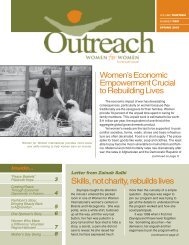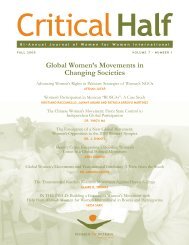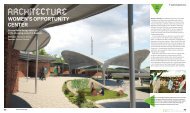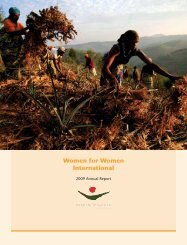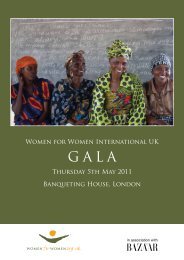Gender and Constitution Building - Women for Women International
Gender and Constitution Building - Women for Women International
Gender and Constitution Building - Women for Women International
You also want an ePaper? Increase the reach of your titles
YUMPU automatically turns print PDFs into web optimized ePapers that Google loves.
to demonstrate that peace agreements should be viewed<br />
as important opportunities to promote gender equality<br />
<strong>and</strong> also provide a useful framework <strong>for</strong> the process of<br />
drafting or revising constitutions. Thus he points out<br />
that the best way <strong>for</strong> women to be involved in the earliest<br />
stages of constitution-building is to have active roles<br />
in the peace process.<br />
The set of articles that follows provides important<br />
insight into the opportunities <strong>and</strong> challenges <strong>for</strong> gender<br />
equality presented by the creation or revision of a constitution<br />
in the aftermath of conflict. In Not Just Representation:<br />
Ensuring <strong>Women</strong>’s Influence in Post-Conflict<br />
Bougainville, Rebecca Linder analyzes the drafting process<br />
<strong>and</strong> provisions in the newly-endorsed <strong>Constitution</strong><br />
of the South Pacific isl<strong>and</strong> province of Bougainville,<br />
signed after years of intense conflict. While its provisions<br />
signal potential <strong>for</strong> improved gender equality,<br />
Bougainville’s lack of governmental capacity, its traditional<br />
governance by community norms <strong>and</strong> customs<br />
<strong>and</strong> lack of public awareness of the <strong>Constitution</strong> are all<br />
obstacles to systemic change.<br />
Afghanistan has drawn the world’s attention as it<br />
struggles to rebuild after decades of war. in The New<br />
Afghan <strong>Constitution</strong>: How <strong>Women</strong> Succeeded in Ensuring Certain<br />
Rights <strong>and</strong> What Challenges Remain, Horia Mosadiq<br />
shares important insight about what Afghan women have<br />
achieved in ensuring protection of their rights within<br />
the <strong>Constitution</strong> <strong>and</strong> potential pitfalls that the process<br />
has illuminated. She also offers very useful guiding principles<br />
<strong>for</strong> promoting equality between men <strong>and</strong> women<br />
in the drafting <strong>and</strong> implementation of a constitution.<br />
Next, Cara Dilts highlights a critical issue that is<br />
relevant in numerous countries—the gap between what<br />
is written in a constitution <strong>and</strong> customary laws that may<br />
restrict women’s rights <strong>and</strong> freedoms in practice. “Engendering”<br />
Rights in Ug<strong>and</strong>a: <strong>Women</strong>’s Struggle <strong>for</strong> Equality<br />
discusses the ef<strong>for</strong>ts of women’s civil society organizations<br />
to translate rights enshrined in the <strong>Constitution</strong><br />
into workable laws <strong>and</strong> how a decade after a new constitution<br />
was created, women still do not enjoy equal<br />
status to men, particularly in the crucial area of property<br />
rights.<br />
Finally, in The Truth Does Not Discriminate: How Post-<br />
Apartheid South Africa <strong>Constitution</strong>alized <strong>Gender</strong> Equality,<br />
Rashida Manjoo discusses how South African women<br />
approached the constitution-building process at the end<br />
of the apartheid era in order to ensure gender equality<br />
<strong>and</strong> prevent marginalization. She also discusses some<br />
of the ways in which the constitutionally-created Truth<br />
<strong>and</strong> Reconciliation Commission was established as a<br />
mechanism <strong>for</strong> redressing grievances that occurred during<br />
apartheid, especially <strong>for</strong> women victims.<br />
Critical Half traditionally closes with a contribution<br />
from one of our field offices. In her article, In the Sea of<br />
Nation-<strong>Building</strong>: Anchoring <strong>Women</strong>’s Rights in the Iraqi <strong>Constitution</strong>,<br />
Manal Omar, <strong>Women</strong> <strong>for</strong> <strong>Women</strong> <strong>International</strong>’s<br />
Regional Coordinator <strong>for</strong> the Middle East <strong>and</strong> North<br />
Africa, discusses a battle whose outcome is yet uncertain—protecting<br />
women’s rights in the legal framework<br />
of Iraq. A survey of 1,000 women conducted by <strong>Women</strong><br />
<strong>for</strong> <strong>Women</strong> <strong>International</strong> in 2004 revealed that 93.7 percent<br />
of Iraqi women want to secure legal rights <strong>for</strong><br />
women, <strong>and</strong> 83.6 percent want the right to vote on the<br />
final <strong>Constitution</strong>. As the article illustrates, this message<br />
from women is loud <strong>and</strong> clear regardless of whether<br />
the legal framework of the final <strong>Constitution</strong> is religious<br />
or secular.<br />
It is our hope that the articles in this issue of Critical<br />
Half provide insight, inspiration <strong>and</strong> guidance <strong>for</strong><br />
countries that are in the midst of or embarking upon<br />
the process of drafting or revising a constitution in the<br />
aftermath of conflict. Sharing lessons between countries<br />
is a critical step in this process.<br />
I would like to express deep gratitude to Catherine<br />
Albertyn, Bathsheba Crocker, Anna Karamanou <strong>and</strong><br />
Sheila Meintjes of our Board of Editors—women who<br />
are instrumental players in the struggle <strong>for</strong> gender equality.<br />
I am also grateful to the tireless ef<strong>for</strong>ts <strong>and</strong> talents<br />
of Managing Editor, Tobey Goldfarb; to the groundwork<br />
laid by Lyla Bashan; to our dedicated copyeditors,<br />
Barbara Bares <strong>and</strong> Rebecca Trinite, <strong>and</strong> designer, Kristin<br />
Hager; <strong>and</strong> to Corey Oser, whose able leadership<br />
brought this journal to fruition. Finally, I thank <strong>Women</strong><br />
<strong>for</strong> <strong>Women</strong> <strong>International</strong>’s supporters whose belief in<br />
the capacity of women survivors of war to define their<br />
futures, makes this publication possible.<br />
Zainab Salbi<br />
President <strong>and</strong> CEO<br />
<strong>Women</strong> <strong>for</strong> <strong>Women</strong> <strong>International</strong><br />
CRITICAL HALF 7



